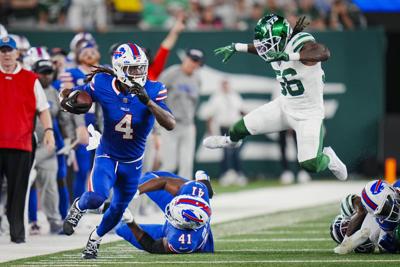ORCHARD PARK — Execution was the word of the day.
In response to a dismal showing on first down against the New York Jets, the Buffalo Bills put the blame on a lack of execution. The Bills certainly didn’t execute well against the Jets, as they averaged 3.7 yards per play, with nine negative plays, five sacks, three penalties and a turnover on first down plays Monday.
As a result, the Bills were in situations that hampered drives almost before they were started. By averaging 8.5 yards to gain on second down, it altered play calls by Buffalo and didn’t force the Jets to be aggressive on second or third down.
When faced with second and 7 or shorter, the Bills eventually recorded a first down or touchdown 11 out of 14 times, compared to five of 11 instances of second and 8 or longer. New York was already playing a defense designed to avoid big plays and minimal yards on first down made some drives a slog.
The Bills call second and 7 or more red areas, while anything less is a green area. Bills offensive coordinator Ken Dorsey says the defense has “at times” an advantage in the red areas, which means the offense has to capitalize on what’s given.
“Being able to still keep them off balance, whether it’s, ‘Hey, if you do get in those scenarios of not letting them sit short, where they’re just thinking get back-on-track-type plays,’” Dorsey said. “But at the same time, hey, if they’re playing soft, being able to either check it down or call some quicker ball out stuff to get you some RAC opportunities, or end up more third and manageable, or try to pop a run in there against a softer two-high shell or something like that.”
When quarterback Josh Allen and coach Sean McDermott said the Jets weren’t running anything complicated defensively, they were correct. They blitzed three times on first down and played two-high safeties on 19 of 28 plays, conceding underneath throws and daring Allen to take risks downfield.
More often than not, Allen took the available throws, going 11 of 14 for 78 yards on first down and averaged 5.8 yards per attempt for the game. But the challenge for a quarterback with the talent of Allen and the weapons he has is the willingness to play conservatively throughout an entire game.
The Bills have been successful against quarterbacks like Patrick Mahomes by playing a similar defense, allowing yards and field goals, but not touchdowns. When Buffalo had drives of nine plays or more, it scored three field goals and a touchdown, but on drives of eight or fewer plays, it had four turnovers and three punts.
All three of Allen’s interceptions were thrown more than 10 yards downfield in the game. If Allen takes the easier throws, it becomes a game of chicken to see who will break first and typically defenses are willing to take more risks to keep an offense from scoring points.
“We always preach to each other on the sidelines, ‘Don’t get bored, don’t get bored,’” Bills receiver Trent Sherfield said. “Getting those short routes, those 5-yard routes and just dinking and dunking it all the way down the field. So I think that’s something that we’re kind of getting back used to.”
Allen playing less risky is certainly a large component of the team’s first-down success, but the Bills so is running the ball. If an offense can pick up at least 4 yards per carry, the defense might be more willing to drop an extra safety into the box or bring in an extra linebacker to help against the run, as the Jets played nickel defense on all but two first down plays.
But while James Cook and the running game had flashes, the Bills managed 61 yards on 3.8 yards per handoff. It was worse on first down, as Buffalo had 28 yards on eight designed run plays and three runs that netted negative yards, usually with Cook being tackled in the backfield before he had a chance.
The Bills had challenges running the ball at times last year, but were successful when they committed to handing off and averaged 5.1 yards per rush on first down last season. Center Mitch Morse says the Bills’ goal for every first down play is gain at least 4 yards each play.
“It’s just being patient and whenever it breaks, it breaks and I just have to take advantage of my opportunities,” Cook said. “... If you wait your turn, it’s gonna come. So just be patient.”
Regardless of how they get it done, the Bills will need to be more prolific on first down to be successful this season. Often the NFL comes down to moving the chains and Buffalo has been in the top-five of the league in first downs in each of the previous three seasons, posting 23.7 first downs per game, compared to 19 against the Jets.
Over the last three years, the Bills have averaged 6.3 yards per play on first down, including 6.2 a year ago. The lowered second down yards to go to 7.5 and the Bills converted second and 7 or fewer 78% of the time.
More efficiency on early downs means better percentages on third downs, a statistic the Bills have led the NFL in two of the last three seasons but went 5 of 13 in Week 1.
“Defenses understand that and more so than than in the past; you really see guys trying to set themselves up to have these longer third downs and second downs,” Morse said. “So trying to make a little disruption on first down, maybe seeing some more movement, maybe a little bit more funkiness than you have in the past. It’s communication and understanding what we do, and just try to be as efficient as possible and first down, not thinking that we’ll make it up in the back-end.”





















Commented
Sorry, there are no recent results for popular commented articles.